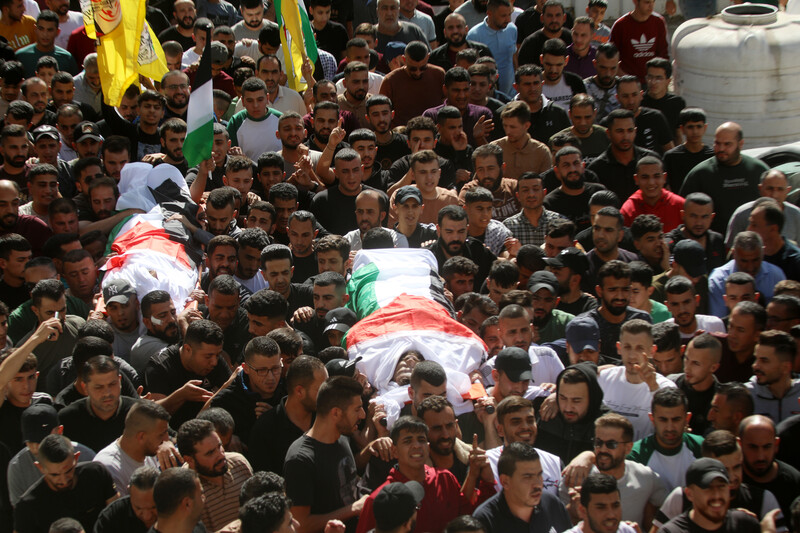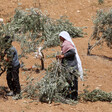Rights and Accountability 8 November 2023

Mourners carry the bodies of two Palestinians, Muhammed Said al-Azeh and Wadi al-Najjar, killed by Israeli forces during a raid on Fawwar refugee camp southwest of the occupied West Bank city of Hebron on 3 November.
APA imagesWhile the world’s attention has been focused on Israel’s genocidal war on the Gaza Strip, Israel’s military and settlers have been relentless in their violence against Palestinians across the occupied West Bank.
Israeli forces have been conducting deadly raids in towns and refugee camps across the territory since 7 October, when Hamas delivered a bloody nose to Israel’s military and political establishment.
Israel hopes to suppress armed resistance in the West Bank as part of these raids, but to also quell any form of dissent to its ongoing genocide in Gaza.
As Israel’s violence in Gaza sets new precedents of scale and brutality, it is also intensifying the scale and frequency of its daily violence across the West Bank, as its forces conducted airstrikes in the area for the first time since the second intifada in recent weeks, and have used drone-fired missiles against Palestinians in the area.
During those raids, Israeli forces destroy Palestinian infrastructure, including roads and electricity networks. They carry out sweeping arrests of residents, raid their homes in the middle of the night and kill children and adults alike.
Simultaneously, the Israeli state – through its foot soldiers, the Jewish fanatic settlers residing in illegal colonies in the West Bank – has been accelerating its plan to displace Palestinian communities from the so-called Area C, the 60 percent of the West Bank that remains under full Israeli military control and includes Israel’s largest settlements.
Israeli settlers and access restrictions enforced by Israeli forces have driven over 900 Palestinians out of their homes and communities since 7 October, according to UN monitoring group OCHA.
That’s more than 110 households in 15 different Bedouin or herding communities.
Israeli settlers threaten Palestinians at gunpoint, vandalize their property, hamper their access to water, ruin their trees, damage their vehicles, steal their belongings and intimidate and physically attack them.
Israeli fire has killed 150 Palestinians in the West Bank since 7 October, and an additional eight were killed by settlers, OCHA has reported.
This constitutes more than one third of all Israeli killings in the area since the beginning of the year.
Forty six Palestinian children have been killed in the occupied West Bank during that period, Defense for Children International-Palestine (DCIP) has said.
Israeli forces have injured nearly 2,400 Palestinians in the West Bank during that period, including more than 250 children, according to OCHA.
More than a quarter of all injuries are due to live ammunition. Israeli settlers have injured more than 60 Palestinians.
Settlers have carried out over 200 attacks against Palestinians since 7 October, according to OCHA.
US-born officer dead
Israeli forces shot and killed a Palestinian child and withheld his body after alleging that he stabbed two Israeli police officers in occupied East Jerusalem on Monday.
Sixteen-year-old Muhammad Omar Froukh allegedly stabbed the two officers near Bab al-Zahra, or Herod’s Gate, just outside Jerusalem’s Old City.
Israeli forces shot him around 8:30 am that morning, according to DCIP. An ambulance evacuated Muhammad’s body an hour and a half later, and Israel is still withholding his body.
“DCIP is unable to confirm how many times Muhammad was shot or the locations of his injuries,” the group said.
Israeli forces shot at him and possibly at one of the officers he allegedly stabbed, according to Israeli media.
The officer died from her wounds. She was an American-born “lone” officer – meaning she moved to Israel without her family – and identified as 20-year-old Elisheva Rose Ida Lubin from a suburb of Atlanta, Georgia.
She had arrived in Israel in August 2021 and had been living in a religious kibbutz in the Negev, southern Israel, since then.
Israeli media circulated a picture Israeli police say is of the knife used by Muhammad to stab the officers. The blade is hardly covered in blood.
Israeli forces later raided the boy’s family home in the East Jerusalem neighborhood of Issawiya, ransacking it and arresting all of Muhammad’s family members.Deadly raids
In the early hours of Tuesday, a large number of Israeli forces raided Tulkarm refugee camp in the West Bank. They were equipped with two crawler bulldozers and a reconnaissance plane.
Israeli snipers were positioned on the rooftops of buildings within the camp and the surrounding area.
The Israeli forces killed four Palestinians.
The Israeli forces fired at people’s homes and vehicles and detonated a drone on the roof of a family house belonging to the al-Banna family, according to Wafa news agency, wounding two of its residents and causing damage to part of the house.
Israeli bulldozers destroyed infrastructure on the main street leading into the camp as well as in some alleys. Israeli forces also damaged electricity poles and commercial shops, and opened fire on an electricity transmitter, causing a power outage in the refugee camp.
Armed Palestinians in the camp engaged in a firefight with the invading Israeli forces.
During a daytime raid the day before, members of the Yamam unit of Israel’s paramilitary Border Police had killed another two Palestinians in the camp. They were named as Qasim Muhammad Rajab and Izz al-Din Awad.
On Monday, Israeli forces raided their homes and even shot Awad’s mother in the shoulder, Wafa reported.
Meanwhile, Israeli forces invaded the town of Abu Dis, fired a missile at a house and killed three Palestinians in the town on 5 November.
An Israeli bulldozer demolished part of the home of Nabil Halabiya, 20, while besieging it. Israeli forces then fired an Energa anti-tank rifle grenade at the house, killing him.
The operation lasted five hours, according to OCHA. Footage circulated by local media shows Israeli forces transferring Halabiya’s body in the blade of a bulldozer.
Israeli occupation forces killed five Palestinians, including a child, during an incursion in the Jenin refugee camp in the northern occupied West Bank on 3 November.This includes two Palestinians who were killed by an Israeli drone-fired missile in the camp, including a child. They were named as Wasim Zyoud, 23, and Yamen Jarrar, 16.
Three others were killed by Israeli fire, and more than a dozen others were injured.
Yamen was allegedly throwing homemade explosive devices toward Israeli military vehicles and bulldozers that entered the area alongside Israeli special forces,” DCIP said.
Israeli drone-fired missiles have killed seven Palestinian children this year, the group said.
Yamen was a student at The Freedom Theater’s Child and Youth Program in the camp, which helps children process their trauma and tell stories using arts and theater.
The group grieved the teenager’s killing in a statement.
“The most challenging situation you can experience is when you realize that Yamen, who is now a martyr, was once right there with you in the same place, playing, laughing and quarreling,” Ranin Odeh, a coordinator of the program, said.
Israeli occupation forces used bulldozers to destroy roads, as well as electricity and water infrastructure leading into the camp.Israeli forces even demolished a memorial statue honoring martyrs at a roundabout.
The deadly Israeli operation lasted for 11 hours, during which armed Palestinians defended the camp.
This was the seventh Israeli incursion into the Jenin refugee camp since 7 October. At least 26 Palestinians have been killed in the incursions.
Jenin refugee camp is a flashpoint of Palestinian resistance in the occupied West Bank, where the Jenin Brigade, a group associated with Saraya al-Quds, the military wing of the Islamic Jihad resistance group, operates.
Israeli forces shot and killed another Palestinian teen in the occupied West Bank that day. Muhammad Wael al-Jabari was participating in a demonstration in the Bir al-Hummus area of Hebron in the southern occupied West Bank when Israeli forces shot him fatally in the chest.
Children
Israeli forces shot a 15-year-old boy as he stood on the rooftop of his home filming their raid of the Jerusalem-area town of al-Eizariya on 3 November. The forces shot Rami Izz Odeh and “shot at everyone that approached the rooftop, preventing anyone from reaching him for about 15 minutes,” DCIP said.
He succumbed to his wounds on 5 November.
Israeli forces shot a 17-year-old boy at a military checkpoint on 3 November, and his whereabouts and condition are unknown. Hamza Zayed Sawafta was driving home in an unregistered car when he arrived at the Tayasir military checkpoint, in the northeast of the occupied West Bank.
“He did not line up in the vehicle queue prompting Israeli forces to yell and shoot at Hamza’s vehicle,” DCIP said.
Hamza complied with Israeli demands to exit the car, put his hands above his head and sit on the ground, but that did not stop Israeli forces from opening fire at him from a distance of less than 20 meters.
Eyewitnesses said Hamza was killed, and his father saw images of his 17-year-old son in Israeli media lying on the ground. Yet Hamza’s father still has been unable to receive confirmation of his death.
During a raid on al-Bireh, a town next to Ramallah, the seat of the Palestinian Authority in the central West Bank, on 2 November, Israeli forces shot and killed a 12-year-old boy in the chest from a distance of about 50 meters. Ayham Muhammad al-Shafi was taken to hospital, where he was pronounced dead on arrival, DCIP said.
A 13-year-old boy succumbed that day to wounds he sustained when Israeli forces shot him in the back of the head while he sat in the backseat of a car driven by his father on 30 October near Zawata.
Hamdan Omar Hamdan was in intensive care until his death.
Meanwhile, Israeli forces shot 16-year-old Abdulrahman Muhammad Jawabra in the chest from a distance of about 100 meters near the entrance of Beit Ummar, a village near the West Bank city of Hebron, on 31 October, killing him.




